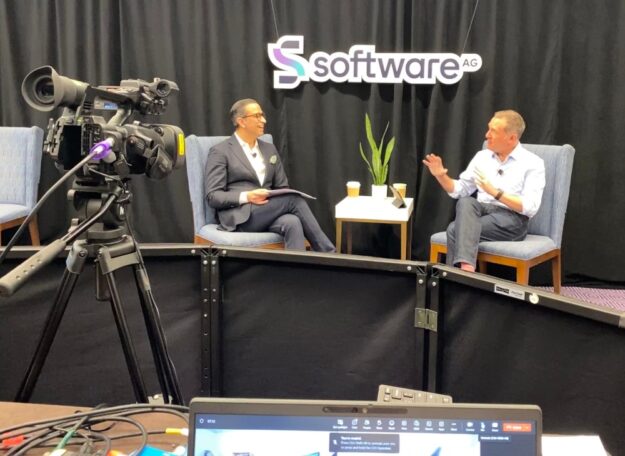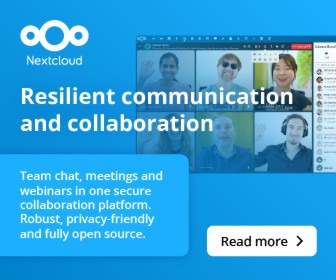At an online media event held in early February, Red Hat’s former CEO talked about investing, open source, open governance, and of course, Red Hat.

At an online media event staged by Germany-based software vendor Software AG earlier this month, former Red Hat CEO Jim Whitehurst was very much the booster for open-source, as well as the open management style inspired by open-source principles that he instituted during his time as Red Hat’s CEO.
That doesn’t mean that all open source advocates are going to be in total agreement with, or even like, his views on the subject. He is, after all, a businessman, an investor, and an advisor, so his views are much more aligned with those of profit-driven enterprises, where the open source development model is a means to an end, than folks who are steeped in the free software philosophy, and who tend to view open-source and free software as the whole enchilada rather than a piece of the puzzle.
During his 20-minute interview by Sanjay Brahmawar, Software AG’s CEO, he also suggested that a use for language-based AI models such as ChatGPT might be to use the platforms to write first drafts of software for computer apps. I’ve heard others express similar, but usually about using AI to clean-up code instead of write it. Indeed, Whitehurst’s statement was a response to Brahmawar’s observation that apps like ChatGPT are good for optimizing code.
“I don’t know if it’s going to optimize others code as much as take the first step,” Whitehurst replied and offered a couple of examples.
“I have a little more free time, so I was writing an iPhone app and I was getting to this section that I didn’t exactly know how to do,” he said. “I just asked chatGPT, ‘Write me something where I can have a bunch of timers in Swift for iOS.’ Bam! Twenty seconds later, I had it. I pasted it in, and then I went and tweaked it and made it better.”
The second example was from his old stomping grounds at Red Hat.
“I was talking to the CEO at Red Hat recently, and one of the things they’ve added into a product called Ansible is basically using natural language — this is from IBM, not from chat GPT, but the same thing — to write a set of automation scripts. Then you can take that — it’s probably not going to be perfect, but it’ll be close — and tweak it to exactly what you want.
“I think it’s more likely that these models will write first drafts of the code, that people go back and tighten up and tailor,” he added. “Honestly, it makes developers much more efficient. I think if it becomes more efficient, it’s not likely to lead to fewer developers, it’s going to lead to more functionality.”
Whitehurst might be C-suite, but his embrace of “The Open Organization” keeps him looking out for the little guy.
Whitehurst on Open Source
I was a little disappointed that Whitehurst didn’t mention open-source, or open organizations, once during the event’s opening 20-minute “roundtable” with Brahmawar, which had an overall focus on what startups can do to attract investor attention.
Whitehurst was there primarily due to his status as a member of Software AG’s board, which was the a result of a $365 million dollar investment in the company by the Silicon Valley-based private equity firm Silver Lake, where Whitehurst is a special advisor.
Although the interview portion of the event made no mention of open source, the Q&A with the press that followed was practically about nothing else but, starting with the first question from DM Radio’s Eric Kavanagh.
“Shouldn’t commitment to open source software be touted as a social value under ESG,” he asked.
“ESG,” for those who don’t know, is a relatively modern investment term (“environmental, social, and governance”) that refers to a set of standards that socially conscious investors apply to a company’s behavior for screening purposes. Over the past decade or so, as concerns about the environment have grown, it’s become a major part of the investment landscape.
“Yes it should, because it is a kind of give back of IP that can be valuable,” Whitehurst answered, then added a caveat. “If you’re not putting it out in a way that is useful, or if you’re not putting it out in a way that can build community, it is the equivalent of greenwashing. It’s like, here’s my code; it’s impenetrable, and I’ve haven’t set it up in a way that anybody else can really use it or contribute or work with it.”
Whitehurst then pointed out that issuing code as open source could offer other benefits to vendors as well.
“I think you attract great technologists and developers into companies,” he said. “Your GitHub history and activity is part of your resume now, so I think it’s important for attracting employees as well, but try to make sure you’re doing it in a way where the code that you’re giving has real meaning.”
The next question about open source came from me, and the problem of having to type in a question to have it read by a moderator without a chance for any real-time back and forth became obvious, because I think Whitehurst misunderstood the question.
I asked about his thoughts on companies “building their software using non OSI-approved licenses such as ‘source available’ and ethical open source licenses.” The answer I got was pretty much the boilerplate answer often offered by enterprise representatives when asked about copyleft versus permissive licensing, both of which are approved by Open Source Initiative.
“There are people who can get really religious around it’s got to be an OSI kind of license,” he said. “I’ve always been a little more practical in that if someone is willing to share code, that’s probably a good thing, so I’ve been less directly concerned about the license. I think there are licenses that do a better job of creating the kind of viral effect for creating the participation that you want, but my view is, and we used to talk about it as ‘the open source way’: it’s less about the license and more about how you are treating communities and trying to build communities, and how to catalyze communities in the early days. So honestly, I’m more interested in companies that are trying to do that, than the specifics of the license.”
My followup question (which came several minutes later and after Whitehurst had moved on to other questions) finally elicited a response that addressed issues with source available and ethical open source licenses.
“But many of these non open source licenses aren’t compatible with the GPL, MIT, or Apache licenses. Isn’t that a problem?” I asked.
“The problem is, if you can’t combine it, it creates a wall to collaboration and therefore innovation,” he answered. “I do think it’s a problem, and I think that we need to continuously do a good job of telling people, ‘No, you need to pick something that allows the software to be built on and used.’ What I don’t want to do is be so dogmatic that you might not get companies who would otherwise build.
“I think it’s even becoming a bigger problem now,” he added, “because frankly there are some open source companies that want to make sure they have a license that really allows them to keep the core proprietary. The thing I always liked about Red Hat is we totally did GPL, and we were able to build a multi billion dollar business on top of it, so I’m very supportive of that. I just want to balance, to make sure that we don’t turn people off of open source too.”
When asked for his thoughts on the importance of open culture within a company, Whitehurst mentioned that earlier that day he had been speaking with a group of investors about how the balance between innovation and efficiency is the “new way to build competitive advantage.”
“I do think culture is super important to be able to build that capability in your ways of working,” he said. “If you’re not able to question your boss, if you don’t have good rich debate, you won’t be able to get to the best solutions or to challenge the status quo, and change is almost always about that. I’m really passionate that beyond technology, you need to have an open culture as a way to build a capability that allows you to innovate or make changes at the pace that you need to win.
He said that he thinks that CEOs are starting to realize that in some ways, digital transformation is more about culture than technology.
“I think there’s a recognition around the importance of much more open cultures, which is hard on these top down organizations that were all built around compliance to a set of plans because that’s how you drove variants out and got better standardization. We’re now saying that we actually want smart variants in, and it’s hard to do that specifically in processes but it’s much easier to do in culture, so build culture.”
Whitehurst: Yesterday and Today
These days, when Whitehurst’s not looking for another Red Hat to run (several press pundits, including me, have said he wants to return to a CEO’s office somewhere), he’s basically spending his time finding companies to put money into. He certainly should have plenty to invest. It’s been reported that at the time of Red Hat’s sale to IBM, he owned 382,057 Red Hat shares, which resulted in a $72.5 million paycheck.
In 2021, several months before stepping down as president at IBM, the job he took after the Red Hat acquisition, he became an advisor to Silver Lake.
“I work with a lot of venture capital firms,” he said during the Software AG event. “I’m a personal investor. I talk to a lot of CEOs that are looking to buy companies as an advisor”
That Whitehurst fits in well with the investor crowd is even less surprising than his success as Red Hat’s CEO. Finances are in his blood. After graduating from Rice University in Houston, Texas in 1989 with a bachelor’s degree in computer science and economics, he spent 12 years as a partner at Boston Consulting Group, one of the world’s three largest management consulting firm by revenue, and earned a MBA from Harvard University during his tenure there.
In 2001, Whitehurst signed on at Delta Air Lines as a senior vice-president, then served for a while as chief network and planning officer before being appointed chief operating officer in 2005 by Gerald Grinstein, who had just become the air line’s CEO. At the time, Delta was in deep financial difficulty, and as COO he successfully negotiated the company through a bankruptcy and was instrumental in successfully stopping a hostile takeover attempt by US Airways.
Whitehurst left Delta in the summer of 2007 after being passed-over for the CEO spot, and signed on as CEO at Red Hat in December of the same year.
He left the air line on good terms and maintained ties with the company after his departure. During my only conversation with Whitehurst, at Red Hat Summit in Boston in the spring of 2019, he mentioned in passing that he was then a board member at Delta, 12 years after he’d left his position as the air line’s COO. Delta also became an important Red Hat customer during his tenure with the open source company.
During his time as Red Hat’s CEO, he famously made it the first open source company with over a billion dollars in annual revenues, and by the time he stepped down after the acquisition by IBM, it was on its way to realizing annual revenues of $5 billion.
Christine Hall has been a journalist since 1971. In 2001, she began writing a weekly consumer computer column and started covering Linux and FOSS in 2002 after making the switch to GNU/Linux. Follow her on Twitter: @BrideOfLinux







